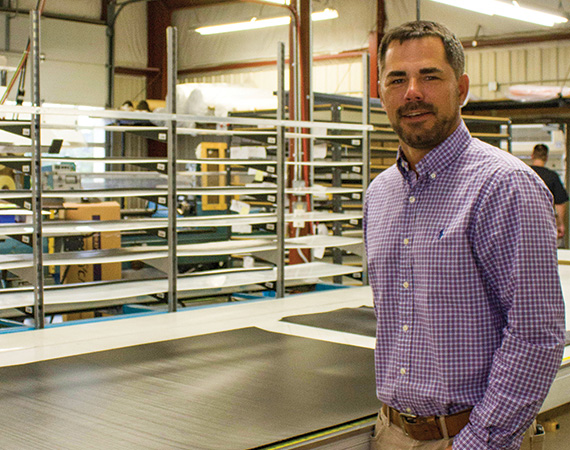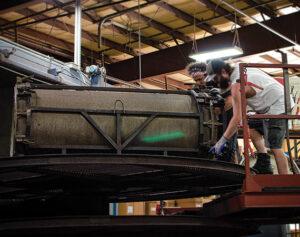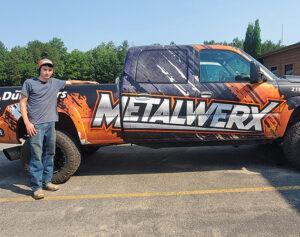Entrepreneur Jeff Engbrecht guided his long-held ambition to own a composites-based manufacturing company with the recognition that their often hefty price tags can easily undo the dazzling innovations enabled by composite engineering.
“Making things is not always the hard part,” says Engbrecht, who today owns Duluth-based Clearwater Composites, a company whose 30-plus employees design and manufacture carbon fiber composites and parts for a wide range of customers nationwide. “The hard part is making money. You have to be adept at business, or it’s not going to work.”
Engbrecht says that manufacturers are attracted to carbon fiber’s combined lightweight and strength but worry that it is expensive relative to other materials. “You have to demonstrate value. It has to save them money on something else or give them better performance.”
Consider how the evolution of the simple hockey stick relates to Engbrecht and his company on two levels: one theoretical, the other life changing. Back in the classic era of the NHL, the likes of Bobby Orr and Gordie Howe muscled and finessed their paths to hockey renown using wooden sticks that traced their lineage to the one-piece chunks of carved wood used by players as far back as the mid-1800s. Manufacturers improved the sticks over time by adding various levels of fiberglass, even aluminum, to the shafts and blades, but the first generation of one-piece carbon fiber sticks that debuted in ice arenas in the early 2000s revolutionized the game forever.
Players valued how the new generation of lighter-weight sticks enhanced more nimble stickhandling, crisper passing and dexterous wrist shots; the slight flex in the shaft added an explosive velocity to the blueline slapshots.
But the new sticks arrived with a considerable tradeoff: price!
In the early 2000s, high school players could invest maybe 20 bucks to hit the ice with virtually the same wooden sticks as their NHL heroes. Today’s carbon fiber composite sticks can cost $300 or more, and they break almost as easily as their wooden predecessors. (And we wonder why hockey parents are crazy.) One report estimated that NHL teams have to budget upwards of $25,000 to keep just one player equipped with sticks for a single season.
To comply with Engbrecht Admonition that composite products must always demonstrate value, the hockey world — from the NHL all the way down to mites — gave it a resounding endorsement. They adopted the expensive new technology as a necessary cost of doing business, ultimately relegating the wooden hockey stick to a place with Pac-Man and the Macarena in the gallery of kitschy cultural artifacts.
So how was this life changing for Engbrecht?
To answer that, we have to go back almost exactly 10 years ago to a jury-rigged composites lab that Engbrecht had built in the basement of his Duluth home. A composite engineer, Engbrecht had already established a 15-year career that spanned the horizon of composite industry experience, from startups to the largest carbon fiber company in the world. At the time, he was working as an application engineer for Ticona Corporation, selling fiber reinforced thermoplastic composites to clients across the country. But his future, he knew, would be entrepreneurial.
Engbrecht outfitted his basement shop using household items and trips to Menard’s to affordably jury-rig a workable composites lab. His favorite adaptation was a repurposed double-decker oven after a kitchen remodel with an insulated pipe added as a fan and a controller from Menard’s. “I’d never done anything like that, but I figured it out,” he says today. “Maybe it wasn’t the safest, but it worked. Nobody got hurt, and we didn’t burn the place down.” (A new oven would have cost $60,000 and would have been too big for his basement.)
In 2009, a former colleague tipped Engbrecht to a manufacturing executive looking for an engineer to help him develop and launch a new generation of composite hockey sticks that could be custom manufactured to fit the playing characteristics of individual players. And he wanted someone outside of hockey.
“He wanted someone with a different set of eyes,” Engbrecht recalls. “I didn’t know how they make them, but I’d figure it out,” he says, launching a nine-month process of reverse-engineering the current lot of carbon fiber sticks and eventually emerging with a viable prototype.
Next, another colleague alerted him to a company that was looking for engineering insights to develop carbon fiber softball bats. The company had initial plans to have the bats manufactured overseas.
Working with Dan Boyum, one of the first employees who still works with Clearwater, Engbrecht developed prototype bats out of his garage. The company was not able to find a reliable overseas source, so Engbrecht rented space and was soon manufacturing the bats under a separate company. The company produced thousands.
Engbrecht calculated it was time to launch his own company. He quit his day job in August 2011 and founded Clearwater Composites. Using guidance from GoDaddy, Engbrecht created his own website and switched on AdWords, Google’s advertising sales platform. The response was immediate. “It was unbelievable,” he remembers.
Within a couple of months, Clearwater was working with an archery company and a kayak company that needed composite shafts for paddles. All projects required tweaking. “There were things that we had to figure out,” Engbrecht says. “It wasn’t just like, oh, here’s your tube in a catalog and go ahead and buy it. There was a lot of niche customizing.”
The process of listening first and then solving challenges became one of Clearwater’s market differentiators, according to Engbrecht. “Our technical ability is one of our core uniques,” he adds.
And the inquiries kept coming. So fast, in fact, that at one point Engbrecht had to switch off the internet.
Engbrecht may have glimpsed his entrepreneurial destiny back in 1990 on a student tour of what was then called Polymer Composites, Inc. Engbrecht, an A-student with a particular interest in math and science — and drawn to the concept of “making things” — watched spellbound as a company rep explained the company’s patent-level work in something called “long-fiber reinforced thermoplastic composites.”
That fascination carried him into the fledgling Composite Materials Engineering program at Winona State University, which to this day is the only such undergraduate program offered in America. “I don’t think I even applied anywhere else,” Engbrecht says, admitting that he was also attracted to the idea of playing collegiate golf alongside several older golf buddies.
Engbrecht combined his love of golf and engineering to launch his career. He used his senior project at Winona State to develop a differential equation that helped predict how various levels of stiffness in composite golf club shafts would affect their performance. This work, and a mutual connection with Dennis Cleveland — a local banker and talented golfer — led to an introduction to Stan Prossen, a pioneer in carbon fiber composites and renal entrepreneur. Prossen had just founded Coda Composites, a Winona-based startup that manufactured violin bows composed of carbon fiber. Engbrecht stayed six years. “We were starting from scratch,” he says. At Coda, Engbrecht helped develop a series of computer programs that would mimic the weight and stiffness of a bow in an effort to replicate the sound of wood.
As a word-of-mouth side product — the internet was not yet a source of business leads — the team at Coda discovered a market for “kite spars,” tapered composite tubes that help stunt kites take maximal advantage of the wind. Stunt kites were enjoying a faddish popularity at the time, and kite enthusiasts appreciated how carbon fiber outperformed fiberglass. After Engbrecht reverse engineered competitive products, Coda sold hundreds of thousands of them, Engbrecht recalls.
The experience roused Engbrecht’s entrepreneurial ambitions, so much so that he rejected an opportunity to become a part-owner at Coda. While the owner wanted to focus on bows, Engbrecht thought the future of composites would help companies use composite to solve all measures of manufacturing challenges. But instead of venturing out on his own, Engbrecht snared an offer from a corporate recruiter and accepted a job in tech sales and marketing in the southern California office of Toray Carbon Fibers America, the world’s largest supplier of carbon fiber.
“I was risk-averse. I wasn’t ready to jump off the cliff into deep waters,” he says. “I just wanted to spread my wings.”
His eight-plus years as a technical manager and marketer at Toray, which also included a stint in Dallas, exposed Engbrecht to the endless potentiality of composites and the inner workings of a massive international corporate bureaucracy. And, at Toray, he sharpened one of his most potent skills. “If somebody has a need for carbon, I can quickly see the technical side but also the business side,” he says. The company also showed Engbrecht “it is hard to make a difference. Decisions take a long time.”
Perhaps most instructive was his exposure to Japanese attitudes about manufacturing and technology, which are much different from prevailing American attitudes.
“They’re not necessarily smarter than us — a lot of them are — but they’re so thorough,” Engbrecht recalls. “When something’s wrong, they look at every detail. They view Americans as sloppy, and for the most part, we are. We rush, and we overlook things.”
By 2007, Engbrecht — now married with a baby — was ready to move his family home to Minnesota. A notice that Cirrus Aircraft was hiring was all he needed. “I’ve always loved the North Shore,” so he took the position. “But my ulterior motive was to get something going on my own. I just didn’t yet know what I was going to do.”
His Cirrus experience was short-lived. The recession of ’08 forced layoffs, and within 18 months, Engbrecht was using his home office to rep for Ticona, the same company that had inspired him in high school. He was also launching his home lab.
Clearwater experienced dramatic 50% per-year growth in its first half-dozen years before leveling off. The COVID economy cut into sales by about 20%, Engbrecht says, but the company used the relief to tighten up its operations.
Like many (maybe all) visionary entrepreneurs, Engbrecht admits to periods of weariness while he attends to his company’s day-to-day operational wheels and levers. “I do get bored sometimes because I have to do things that I don’t always want to do,” he says. “But it goes in waves.” Time on the golf course provides some summer relief, he says, but the expanded capacity of his new building promises to reinvigorate his creativity, he adds. “We have an opportunity to grow again. We have a million ideas about things we can do.”
Engbrecht’s vision for letting his new facility mark a significant plot-point in Clearwater’s future also includes an evolution in management. Engbrecht intends to steer the company’s next phase of strategic growth using the Entrepreneurial Operating System (EOS), a popular holistic approach to managing entrepreneurial cultures conceived by author Gino Wickman. A long-standing disciple of Wickman’s insights, Engbrecht acknowledges that his personal work traits fit Wickman’s portrayal of successful entrepreneurs. He’s a passionate visionary whose drive for success is found in a love of problem-solving. He can still barely conceal his glee at listening to a customer’s challenges and then plotting composite-driven solutions based on his own experience and creativity.
But those traits also reveal some challenges. Engbrecht, a “participatory” manager, acknowledges he must loosen his grip on day-to-day activities if Clearwater can systematize its procedures and empower trusted employees to implement them. Engbrecht, like most innovating entrepreneurs, built his company on a foundation of skills, instincts, and passion. “I was very hands-on to come up with solutions and make sure they’re working. I would go make the part and then to some degree oversee the production of the product — making sure it was done right and then shipped out the door.”
Wickman advises entrepreneurs to recruit “integrators” to whom they can delegate their organization’s operations and growth. Engbrecht recently recruited David Baughman as a “fractional” — part-time — integrator. A fractional integrator is an incremental step to adding a full-time COO. Baughman works remotely from his home in Texas 10-15 hours each week, and visits the Clearwater plant monthly.
Baughman brings skills and experiences on the production operation side through lean and continuous improvement, areas in which Engbrecht lacks experience. “I know what they are, but I’ve never lived and breathed them,” he says. “They make the process a well-oiled machine,” he says. “They make things better and reduce defects.”
Engbrecht continues to play the “integrator” role on the financial side, where he says he knows the details better than the typical visionary. “They usually just want to see the bottom line, and they’re not going to get into the details of costs and margins,” he says. “I like doing that. So yes, Baughman has really helped. It’s been working well.”
Baughman’s responsibilities will be to help ensure that Clearwater is able to recruit and retain a quality workforce in an era of chronic employment shortages. Clearwater’s leadership team recently gathered to set three-year goals, one financial and one related to people. “We’d love to be a great company where people are knocking on our door to work here,” Engbrecht says.
“It’s just smart business and common sense to treat people fairly, pay them well, and give them a good opportunity to grow.”
Part of the tactic is to groom a culture that won’t lament departures. If people leave, he says, “I’m happy that they grew with us. I’ll hate to lose them, but that’s just life.”
…
Featured story in the Fall 2021 issue of Enterprise Minnesota magazine.


